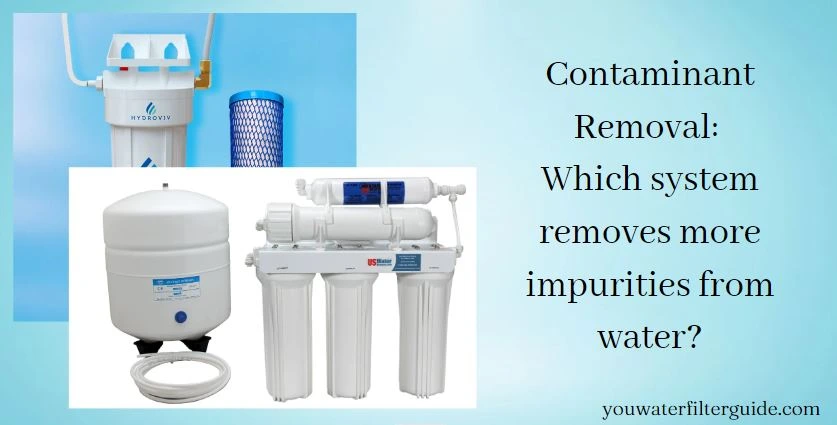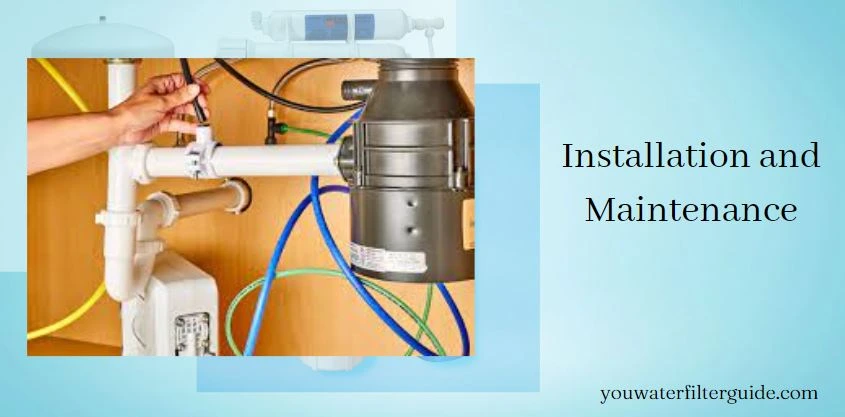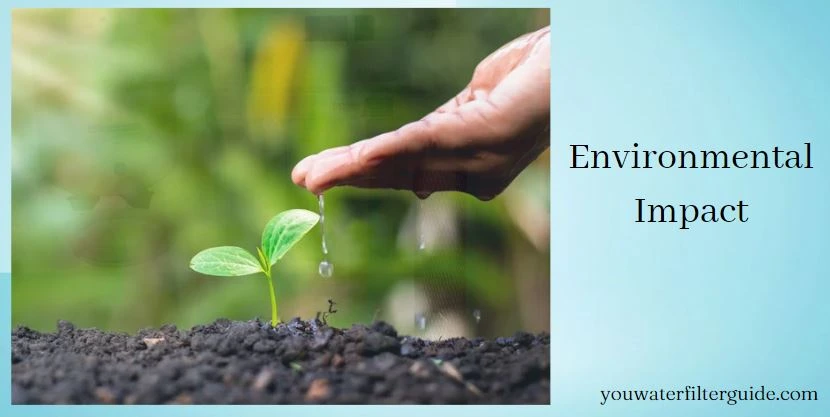Water is essential for life, but unfortunately, not all water is safe to drink. Contaminants like lead, arsenic, and bacteria can make their way into our water supply, putting our health at risk. That’s where water filters come in.
With so many different types of filters on the market, it can be tough to choose the best one for your home. In 2023, two of the most popular options are Hydroviv and Reverse Osmosis. Both claim to provide clean, safe drinking water, but which one is the better choice?
In this article, we’ll compare Hydroviv and Reverse Osmosis to help you make an informed decision about which water filter is the best fit for you and your family.
Did you know?
Before the 19th century, there were only a few small-scale air filtration systems. However, in the 1800s, the first large-scale water filters were developed for domestic use. These filters were typically slow sand filters or mechanical filters. The Scottish city of Paisley is credited with being the first to have a filtered water supply for an entire city, using an early version of a slow sand filter starting in 1804.
Overview
Hydroviv
Hydroviv is a water filtration system brand that removes impurities from drinking water using activated carbon block technology. Hydroviv systems are customized based on water quality challenges in various places.
Hydroviv filters are also environmentally friendly, with a focus on decreasing water waste and the usage of plastic in filter cartridges. The company provides a variety of products, ranging from under-sink filters to whole-house filtration systems, and has a reputation for providing practical and high-quality water filtering solutions.
Reverse Osmosis
Reverse Osmosis (RO) removes impurities from water by using semi-permeable membranes. Water is forced through the membrane in the RO process, which has tiny pores that allow water molecules to pass through but block larger particles, chemicals, and microorganisms.
In addition to the membrane collecting filtered water, sediment and carbon filters are usually included in RO systems to remove larger particles and improve taste and odor. Water treatment applications such as residential, commercial, and industrial use reverse osmosis to remove heavy metals, dissolved salts, and other contaminants.
Filtration Technology: How do Hydroviv and Reverse Osmosis systems work?
Filtration technology is an essential component of water treatment systems, including Hydroviv and Reverse Osmosis (RO) systems. Below are the differences between Hydroviv and Reverse Osmosis in terms of filtration technology.

Hydroviv | Filtration Technology | Reverse Osmosis |
Activated Carbon Block | Main Mechanism | Reverse Osmosis Membrane |
Ion Exchange Resin, Sediment Filter | Additional Mechanisms | Sediment Filter, Carbon Block |
0.5 microns | Filter Pores | 0.0001 microns |
Lead, Chlorine, PFAS, PFOA, Arsenic, Chromium 6, VOCs, and more | Contaminants Removed | Lead, Chlorine, PFAS, PFOA, Arsenic, Chromium 6, VOCs, bacteria, and more |
Hydroviv and Reverse Osmosis are two types of water filtration technologies that remove contaminants from water.
Hydroviv uses a combination of activated carbon block, ion exchange resin, and sediment filter to remove lead, chlorine, PFAS, PFOA, arsenic, chromium 6, VOCs, and other contaminants. The filter pores are 0.5 microns, and the system produces minimal wastewater.
On the other hand, Reverse Osmosis uses a main mechanism of a reverse osmosis membrane, along with sediment filter and carbon block as additional mechanisms, to remove the same contaminants as Hydroviv, as well as bacteria. The filter pores are much smaller at 0.0001 microns.
Contaminant Removal: Which system removes more impurities from water?
The elimination of contaminants is an important component in determining the efficacy of a water filtering system. Selecting a water purification system that removes more contaminants will give you safe and clean drinking water.
It’s critical to examine the level of contaminant removal provided by various systems to ensure you’re getting the optimum protection for your health and well-being.Here’s a table comparing the contaminant removal of Hydroviv and Reverse Osmosis (RO) systems:

Hydroviv | Contaminant | Reverse Osmosis (RO) |
Yes | Lead | Yes |
Yes | Chlorine | Yes |
Yes | PFAS | Yes |
Yes | PFOA | Yes |
Yes | Arsenic | Yes |
Yes | Chromium 6 | Yes |
Yes | VOCs | Yes |
No | Bacteria | Yes |
Minimal | Wastewater produced | 3-10 gallons per gallon |
Every 6 months | Filter replacement | Every 1-2 years |
More expensive | Cost | More affordable |
Overall, both Hydroviv and Reverse Osmosis systems are effective at eliminating a wide spectrum of impurities from water.
However, RO systems have a modest advantage in removing bacteria and have smaller filter holes, which can remove even smaller pollutants. Hydroviv, on the other hand, produces less wastewater, requires more regular filter changes, and is more expensive initially.
The decision between the two systems is ultimately determined by the user’s demands and preferences.
Installation and Maintenance: Which system is easier to install and maintain?
Which system is simpler to set up and maintain? There is no correct or incorrect answer. The option is determined by the type of water you want to filter and the volume of water you want to ingest. Below is the comparison of both products:

Hydroviv | Aspect | Reverse Osmosis (RO) |
Under sink or countertop | Installation | Under sink or countertop |
Compact | Space required | Larger than Hydroviv |
Requires normal water pressure | Water pressure | Requires higher water pressure |
Minimal | Wastewater production | 3-10 gallons per gallon |
Every 6 months | Filter replacement | Every 1-2 years |
N/A | Membrane replacement | Every 2-4 years |
Occasional cleaning of filters | Other maintenance | Occasional cleaning of filters |
10+ years | Lifespan | 5-10 years |
According to the table above, both systems are put beneath the sink or countertop, but Hydroviv is more compact than RO and requires standard water pressure, whereas RO requires greater water pressure.
Hydroviv produces less effluent than RO and requires filter replacement every six months, whereas RO requires filter replacement every 1-2 years and membrane replacement every 2-4 years. Both systems require periodic filter cleaning and have differing lifespans, with Hydroviv lasting over ten years and RO lasting 5-10 years.
Overall, Hydroviv is thought to be simpler to install and maintain than Reverse Osmosis systems, owing to its small size, low maintenance requirements, and lack of membrane replacement.
Key Features: Hydroviv vs. Reverse Osmosis Drinking System
Hydroviv | Reverse Osmosis Drinking System |
Good Capacity | Purified water |
Large capacity for multiple users | 99.9% pure water for improved taste and health benefits |
Easy to install | No plastic bottles required |
Made with high-quality materials | Space-saving design for small spaces |
Enhances water taste | Simple to set up and use |
Long-lasting filters for cost and waste reduction | |
Removes harmful contaminants such as lead and chlorine | |
Improves water pressure in pipes and fixtures | |
Certified and tested by third-party organizations |
Hydroviv:
One of the features of the Hydroviv water filter system is its good capacity, which makes it suitable for multiple users. The filter can be used for the whole family or guests without having to worry about running out of water quickly. Another great feature is that it is easy to install no expert help or additional assistance is required.
The product is made with high-quality materials, so it is durable and lasts for years of use. It also enhances water taste through a unique filtration process that removes sediment and contaminants while improving the flavor. The filters are also long-lasting, which helps to reduce costs and waste.
Pros | Cons |
· Affordable. · It comes with a filter that can be replaced easily. · Includes a Long-lasting filter. · The company has excellent customer service. | · Does not work well with some types of water sources · Needs space underneath the sink. |
Reverse Osmosis Drinking System:
The Reverse Osmosis Drinking System produces purified water that is 99.9% pure, making it ideal for improved taste and health benefits. The system removes harmful contaminants such as lead and chlorine, which can affect the quality of water.
Additionally, it improves water pressure in pipes and fixtures. The system is also easy to install, use, and no plastic bottles are required. It has a space-saving design, which makes it perfect for small apartments and dorm rooms.
The system is certified and tested by third-party organizations, ensures that it meets high-quality standards.
Pros | Cons |
· It is portable. · It removes 99% of contaminants, including lead, nitrates, and other heavy metals · It is affordable | · It takes a long time to filter the water · The filter needs to be changed regularly. |
Overall, Hydroviv and Reverse Osmosis Drinking Systems are excellent water filtration systems with unique features that cater to different needs. Depending on your specific requirements, you can choose one that best suits your needs.
Environmental Impact: Which system is more eco-friendly and sustainable?

Both Hydroviv and Reverse Osmosis Drinking Systems offer eco-friendly features that promote sustainability. Hydroviv’s filters last for a long time, which helps reduce waste and cost. It also helps prevent harmful contaminants from entering the water supply. However, it’s important to note that it’s not a zero-waste system since filters will eventually need to be replaced.
On the other hand, the Reverse Osmosis Drinking System can help eliminate the need for plastic water bottles since it produces purified water that can be stored in reusable containers. The high level of water purity can also reduce the need for single-use plastic bottles. However, the process of reverse osmosis can be energy-intensive, which may affect its overall sustainability.
In summary, both systems have eco-friendly benefits, and choosing between them may depend on personal preferences and specific sustainability goals.
Things to consider before you buy water filtration systems
When choosing between the Hydroviv and Reverse Osmosis water filtration systems, there are a few things to keep in mind.
- Space in your home
You need to consider the available space in your home for a filtration system. While some systems are small enough to fit on a countertop or under a sink, others require more space and may need professional installation by a plumber.
- the type of water system available in your area
If your municipality has a water treatment plant, then the filters they use may be the best choice for you. However, if not, you’ll need to consider other filtering options.
- Ion exchange filter
If your water has high levels of iron or sulfur, you might consider an ion exchange filter. This system replaces these elements with sodium or potassium ions, which are much less harmful to humans.
- Maintenance
Some filters need monthly maintenance, while others only require cleaning every six months.
- carbon filter
If you are concerned about lead and other heavy metals, an activated carbon filter may be the best option for you. This type of filter removes contaminants from your water by adsorbing them onto its surface.
Ultimately, every home should have at least one water filter installed. If yours doesn’t have one yet, now is the perfect time to consider which water filtration system is best for you.
Key Takeaways

Hydroviv and Reverse Osmosis Drinking Systems offer unique features, benefits, and limitations. Hydroviv boasts a large capacity, easy installation, and long-lasting filters that reduce waste and costs, while also improving water taste by removing harmful contaminants. On the other hand, the Reverse Osmosis Drinking System produces highly purified water, eliminating the need for plastic bottles, and has a space-saving design that’s easy to set up and use.
In terms of sustainability, both systems have their pros and cons. Hydroviv’s long-lasting filters are cost-effective, but they need replacement eventually. The Reverse Osmosis Drinking System eliminates plastic water bottles, but the reverse osmosis process consumes a lot of energy.
When choosing between these two systems, it’s crucial to consider your specific needs, preferences, and sustainability goals. Furthermore, user feedback and satisfaction can help evaluate the overall performance and user experience of each system.




